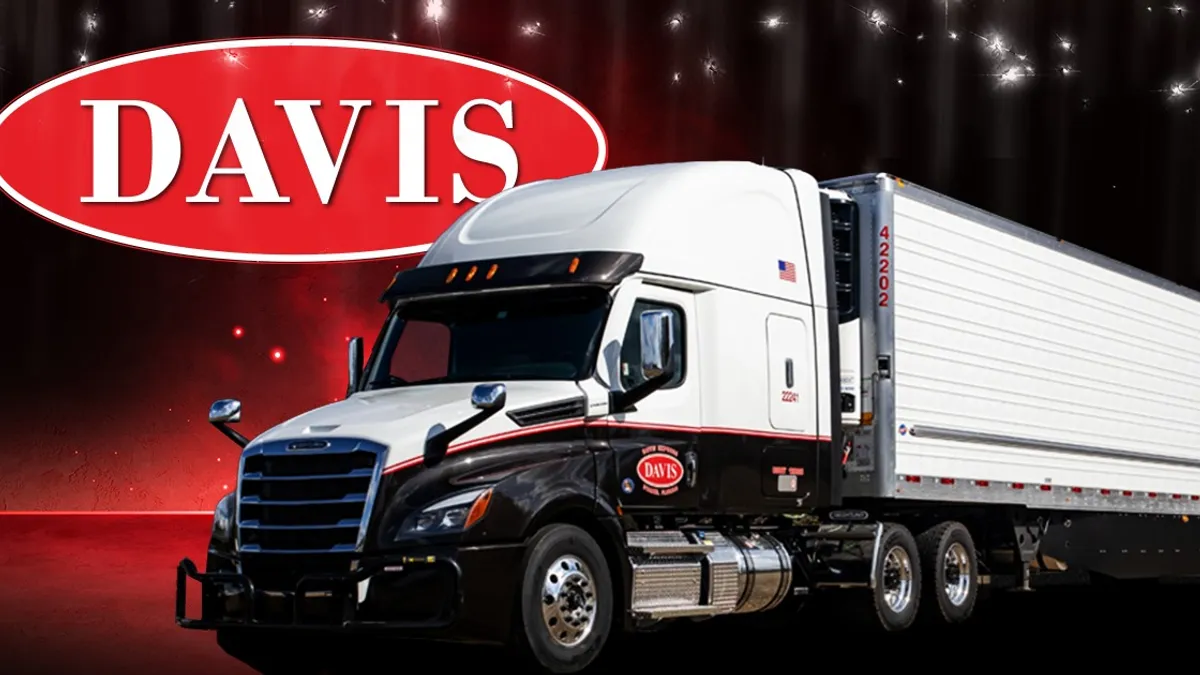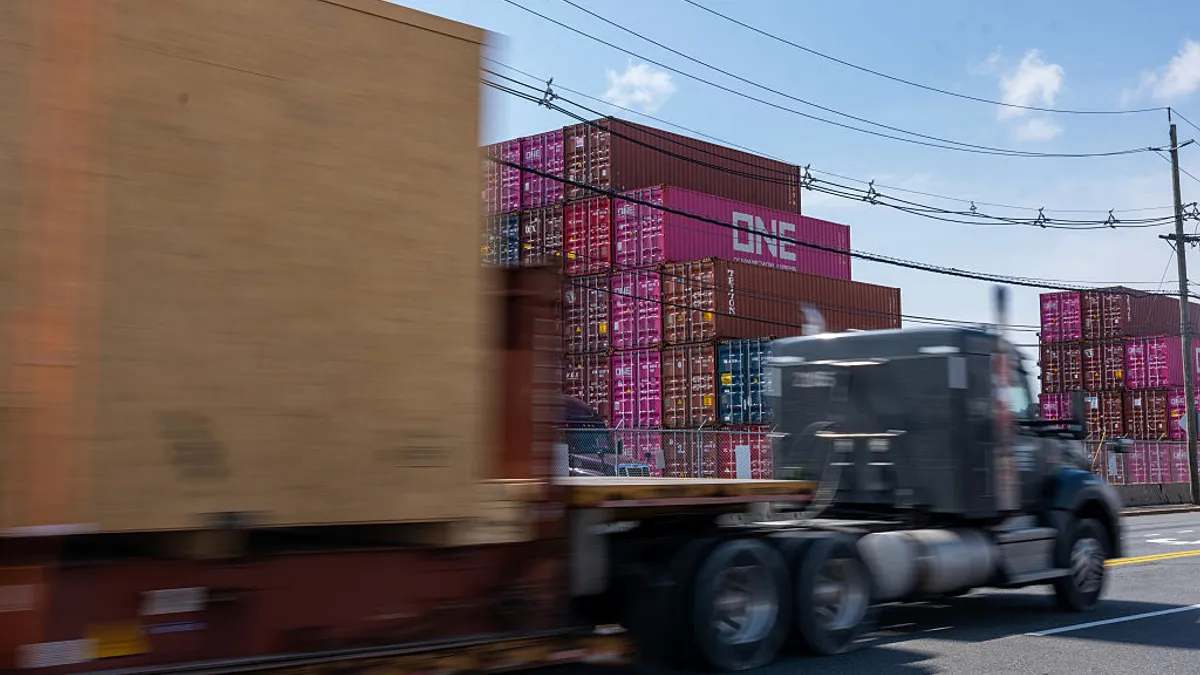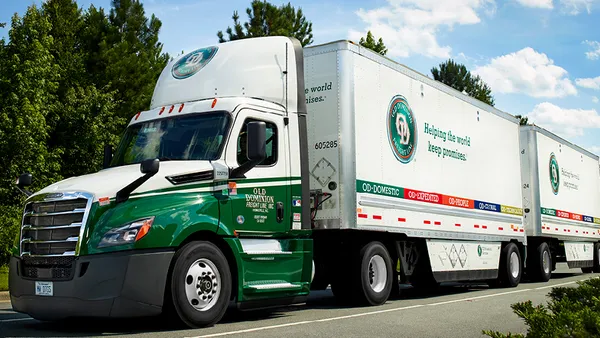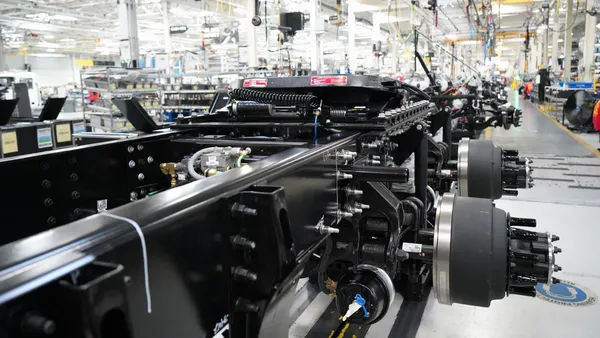Part of 2020 and 2021 so far have proved to be blockbuster for trucking. Consumer demand kept shippers busy and pleading for space, while the supply of tractors, trailers and drivers remained tight.
But not all trucking firms benefit equally from the continuing freight boom. As in every industry, some transport firms are financially healthier than others, according to data from RapidRatings, which assesses the financial health and risk of publicly traded companies.
"In many ways, the trucking companies can craft their own destiny, given the ... demand for goods movement," said James Gellert, CEO of RapidRatings.
The tables below show the financial health for 20 of the largest publicly traded trucking firms in North America, using two metrics:
- Financial health rating: FHR is a measure of short-term resiliency and risk of default; it is based on liquidity, earnings performance and other factors.
- Core health score: CHS is a measure of medium-term risk and efficiency. Gellert described CHS as a company's ability to weather an internal or external storm.
The average FHR across industries in the U.S. in 2020 was 54.6, Gellert said, and most trucking firms' FHR scores are well above that average.
"It's a decidedly strong group of companies," Gellert said.
Trucking's financial health in Q2 2021
Trucking's core health in Q2 2021
Digging into Q2's results
Old Dominion kept its winning streak
For years, Old Dominion Freight Line has maintained the highest FHR among the large trucking companies in North America. The LTL carrier consistently receives FHR scores in the 90s; 80-100 is classified as "very low risk" of a default.
Old Dominion has aimed to differentiate itself by focusing on the expansion of its service center network.
"We have been extremely consistent even going back to the recession of 2009," CEO Greg Gantt told Transport Dive last year. "We did not cut service."
In the current market, Old Dominion continues to build up headcount and capacity, according to a September note from Morgan Stanley analysts. Executives at the trucking firm anticipate freight demand and pricing remaining strong into next year, the Morgan Stanley note said.
"If current trends persist it would be logical to expect that Old Dominion Freight Line Inc will face very low default risk this coming year while prospects for enhancing efficiency and competitiveness are excellent over the medium-term," stated a RapidRatings FHR report.
And long term, management foresees additional growth, in part due to the shift to e-commerce, according to Morgan Stanley.
Old Dominion
More on ODFL:
- How Old Dominion's service-center strategy drives LTL success
- Company of the year: Old Dominion Freight Line
Yellow is at 'high risk'
The troubled carrier's Q2 score was 32, putting it in the "high risk" category (20-39). It's a dip from most of 2020 when Yellow was able to maintain scores in the 40s, classified as "medium risk."
Yellow also saw the largest YoY drop in FHR (down 15 points) of the carriers analyzed. Of the last 10 quarters, Yellow's net income was positive in just one.
Last year, when Yellow was on the brink of collapse, it received a $700 million loan from the Treasury Department, and the agency took a 30% stake in the company. As of July 31, Yellow has fully drawn that loan, using the funds for pensions, healthcare payments, tractors and trailers. Its focus in the near term is yield over volume, CFO Dan Olivier told analysts in August.
Some of Yellow's financials, such as operating revenue, operating income and adjusted EBITDA, have improved compared to 2020, Olivier said. Still, from Q2 2020 to Q2 2021, Yellow's free cash flow was negative $564 million. Free cash flow and debt "levels of this magnitude can indicate a challenged solvency profile," according to a RapidRatings FHR report.
"Despite the surge in fortunes for transportation companies, [Yellow] remain[s] unprofitable on a GAAP basis," Gellert said.
Yellow
More on Yellow:
Daseke's FHR improved the most YoY
The flatbed carrier's Q2 score was 77, up from 29 in Q2 2020. That's a change from "high risk" to "low risk."
Daseke's net income parallels the change. Quarterly reports throughout 2019 revealed net income in the red. But since last June, net income has been in the black with the exception of one quarter.
"Our balance sheet remains a point of strength," Jonathan Shepko told analysts in August as he assumed the role of permanent CEO. The company had free cash flow of $32.3 million in Q2.
A strong construction market has helped to buoy Daseke, although the firm has also diversified into several other markets to keep its business shielded from volatility in any one sector. If net income continues its trend in the black, it's likely the longer-term CHS could show improvement alongside the FHR.
Daseke
More on Daseke:
Covenant turns around its core health
Covenant Logistics Group's CHS jumped from 28 in Q1 to 72 in Q2, a change from "poor" to "strong" in the measure of long-term sustainability and operating efficiency. Its shorter term FHR score also improved by 25 points, a change from medium risk of default to very low risk.
"Covenant's profitability margins were razor thin for a few quarters in 2020 but have now recovered," Gellert said.
It's tough to pinpoint one reason for the widening margins, but Covenant is in the midst of a transformation to a full-service logistics provider. It started the change in 2015 but began to see traction this year, said President Joey Hogan on the company's latest earnings call.
The strong freight and warehousing market during the pandemic helped Covenant's top-line growth. Still, executives remain cautious.
"Gross margins and volumes can be volatile," Hogan said. That's one of the reasons the logistics firm is forming partnerships with shippers in segments such as warehousing and brokerage, so it's less susceptible to the ebbs and flows of the market.
Jack Atkins, managing director at Stephens, said Stephens believes Covenant is "well down the road" to securing long-term pricing and contracts with large shippers. Nailing down those agreements "should help partially lock in these profit streams, which have been a strong tailwind to earnings this year," Atkins wrote in a July note.
Overall, Covenant is playing the long game. "We're taking a very long-term strategic approach," Hogan said, referring to dedicated. In general, long-term strategies lead to stabilization in core financial health.
Covenant
How should execs use these ratings?
Executives at the trucking firms listed in the tables above can use FHR and CHS to assess the current state of their business, Gellert said. They can determine if the scores are acceptable to management, shareholders, and prospective or current customers, compared to other options the customers have.
Shippers, 3PLs and independent carriers can use the results for competitive analysis, to determine with which firms they want to partner. Shippers looking for long-term stability and contracts may be more inclined to choose a provider with a higher core health score.
"No one wants to sign a five-year deal with a company with a weak core health," Gellert said. "But they might sign a one-year deal with a weak core health company if the financial health is high enough."
That dichotomy is particularly relevant in trucking. Shippers looking to the spot market won't put a lot of stake into core health, because short-term problems are unlikely. But with dedicated freight, longer-term health becomes a greater consideration.
Technology vendors may also want to take a closer look at companies with strong scores, as those firms will more likely have the cash flow to invest in software or hardware.
Financial resilience and company efficiency are especially important in the current freight landscape. Supply chain disruption — whether it's a lack of drivers or a flood of volume from jampacked railroads — will have a greater impact on firms with lower scores than those with higher ones who are more able to adjust to ebbs and flows of the external environment.
Historically, more than 90% of companies that have failed over the last two decades have had ratings below 40, Gellert said.
"That does not mean that a company that is a 39 is going to fail. But it does mean that the propensity for failure is higher," he said.
Methodology: Transport firms were selected based on Transport Topics' Top 100 For-Hire rankings, with a focus on companies with owned assets. FHR and CHS assess publicly-traded companies.




















